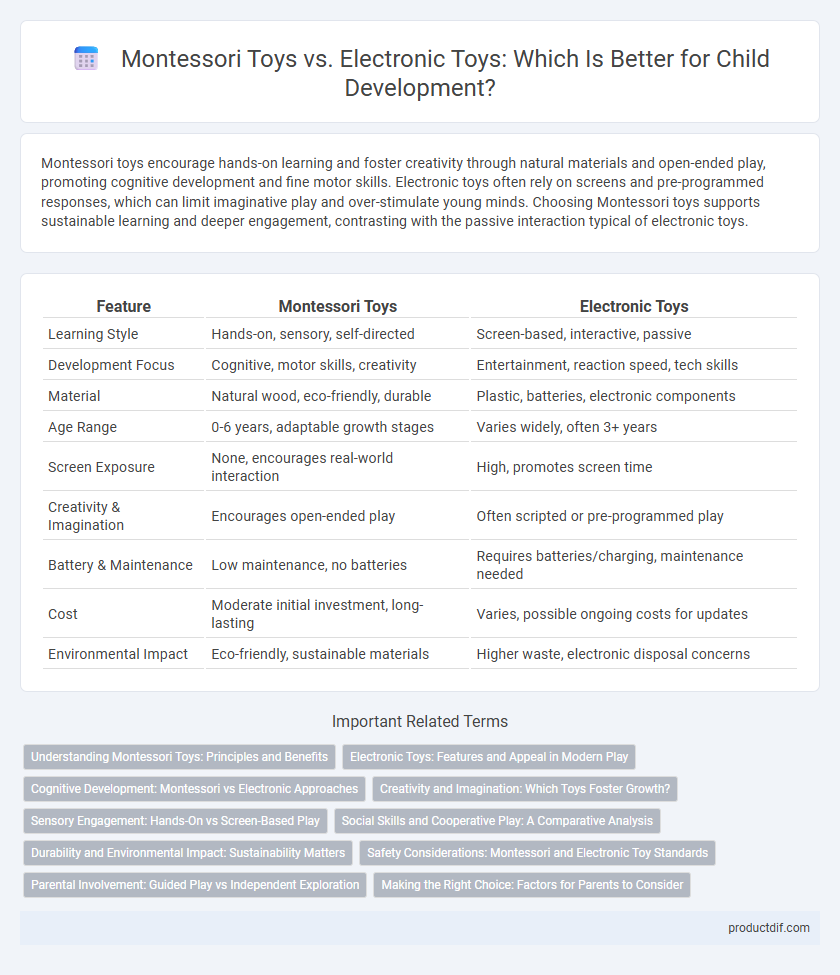Montessori toys encourage hands-on learning and foster creativity through natural materials and open-ended play, promoting cognitive development and fine motor skills. Electronic toys often rely on screens and pre-programmed responses, which can limit imaginative play and over-stimulate young minds. Choosing Montessori toys supports sustainable learning and deeper engagement, contrasting with the passive interaction typical of electronic toys.
Table of Comparison
| Feature | Montessori Toys | Electronic Toys |
|---|---|---|
| Learning Style | Hands-on, sensory, self-directed | Screen-based, interactive, passive |
| Development Focus | Cognitive, motor skills, creativity | Entertainment, reaction speed, tech skills |
| Material | Natural wood, eco-friendly, durable | Plastic, batteries, electronic components |
| Age Range | 0-6 years, adaptable growth stages | Varies widely, often 3+ years |
| Screen Exposure | None, encourages real-world interaction | High, promotes screen time |
| Creativity & Imagination | Encourages open-ended play | Often scripted or pre-programmed play |
| Battery & Maintenance | Low maintenance, no batteries | Requires batteries/charging, maintenance needed |
| Cost | Moderate initial investment, long-lasting | Varies, possible ongoing costs for updates |
| Environmental Impact | Eco-friendly, sustainable materials | Higher waste, electronic disposal concerns |
Understanding Montessori Toys: Principles and Benefits
Montessori toys emphasize hands-on learning, sensory development, and independence through natural materials and simple designs that foster creativity and problem-solving skills. These toys support cognitive growth by encouraging exploration and fine motor skill development without overstimulation from lights or sounds. Research shows children engaging with Montessori toys exhibit enhanced concentration and practical life skills compared to those frequently playing with electronic toys.
Electronic Toys: Features and Appeal in Modern Play
Electronic toys often feature interactive screens, sound effects, and programmable functions that enhance sensory stimulation and cognitive engagement in children. These toys appeal to modern play by integrating technology that supports learning through games and multimedia content, encouraging problem-solving skills and creativity. Advanced electronic toys also offer connectivity with apps and smart devices, providing personalized play experiences and adapting to a child's developmental progress.
Cognitive Development: Montessori vs Electronic Approaches
Montessori toys encourage hands-on learning and sensory exploration, fostering critical thinking and problem-solving skills essential for cognitive development. Electronic toys often rely on passive interaction and pre-programmed responses, which may limit opportunities for creativity and independent learning. Research indicates that Montessori-based play supports long-term cognitive growth by promoting active engagement and intrinsic motivation.
Creativity and Imagination: Which Toys Foster Growth?
Montessori toys enhance creativity and imagination by encouraging hands-on exploration and problem-solving through natural materials and open-ended play. Electronic toys often provide structured interactions that can limit imaginative thinking by guiding children with preset responses and digital feedback. Prioritizing Montessori toys supports cognitive development by fostering independent learning and innovative thought processes in early childhood.
Sensory Engagement: Hands-On vs Screen-Based Play
Montessori toys emphasize hands-on sensory engagement, encouraging tactile exploration, fine motor skills, and cognitive development through natural materials and real-world objects. Electronic toys primarily offer screen-based play, which can limit physical interaction and often depend on visual and auditory stimuli without fostering deep sensory experiences. Research shows that hands-on play with Montessori toys promotes better sensory integration and sustained attention compared to passive screen time with electronic toys.
Social Skills and Cooperative Play: A Comparative Analysis
Montessori toys promote social skills and cooperative play by encouraging hands-on interaction and communication among children, fostering teamwork and empathy. Electronic toys often emphasize individual use, which can limit opportunities for collaborative learning and social engagement. Emphasizing tactile exploration, Montessori toys develop problem-solving abilities and social cooperation more effectively than screen-based electronic alternatives.
Durability and Environmental Impact: Sustainability Matters
Montessori toys are crafted from natural, sustainable materials such as wood and organic cotton, ensuring higher durability and less environmental harm compared to electronic toys that often contain plastic and non-recyclable components. Wooden Montessori toys can last for generations, reducing waste and the need for frequent replacements, while electronic toys contribute significantly to e-waste challenges due to battery and circuit board disposal. Choosing Montessori toys supports eco-friendly play by minimizing resource consumption and promoting long-lasting, biodegradable products.
Safety Considerations: Montessori and Electronic Toy Standards
Montessori toys prioritize natural materials and simple designs that promote safe tactile exploration, adhering to strict non-toxic and choking hazard regulations. Electronic toys must comply with rigorous electrical safety standards, including battery safety and electromagnetic compatibility, to prevent injury and malfunction. Both types of toys require certifications such as ASTM F963 or EN71 to ensure safe play environments for children.
Parental Involvement: Guided Play vs Independent Exploration
Montessori toys encourage parental involvement through guided play, fostering hands-on learning and cognitive development by promoting interaction and skill-building. Electronic toys often support independent exploration, offering sensory stimulation and immediate feedback that can enhance problem-solving but may reduce opportunities for parent-child bonding. Balancing these approaches helps optimize a child's growth by combining structured guidance with autonomous discovery.
Making the Right Choice: Factors for Parents to Consider
Montessori toys emphasize hands-on learning, creativity, and sensory development, promoting fine motor skills and cognitive growth without electronic distractions. Electronic toys often offer interactive features and instant feedback but may limit imaginative play and physical activity. Parents should assess their child's developmental needs, screen time balance, and the toy's ability to foster independent exploration when making the right choice.
Montessori toys vs electronic toys Infographic

 productdif.com
productdif.com